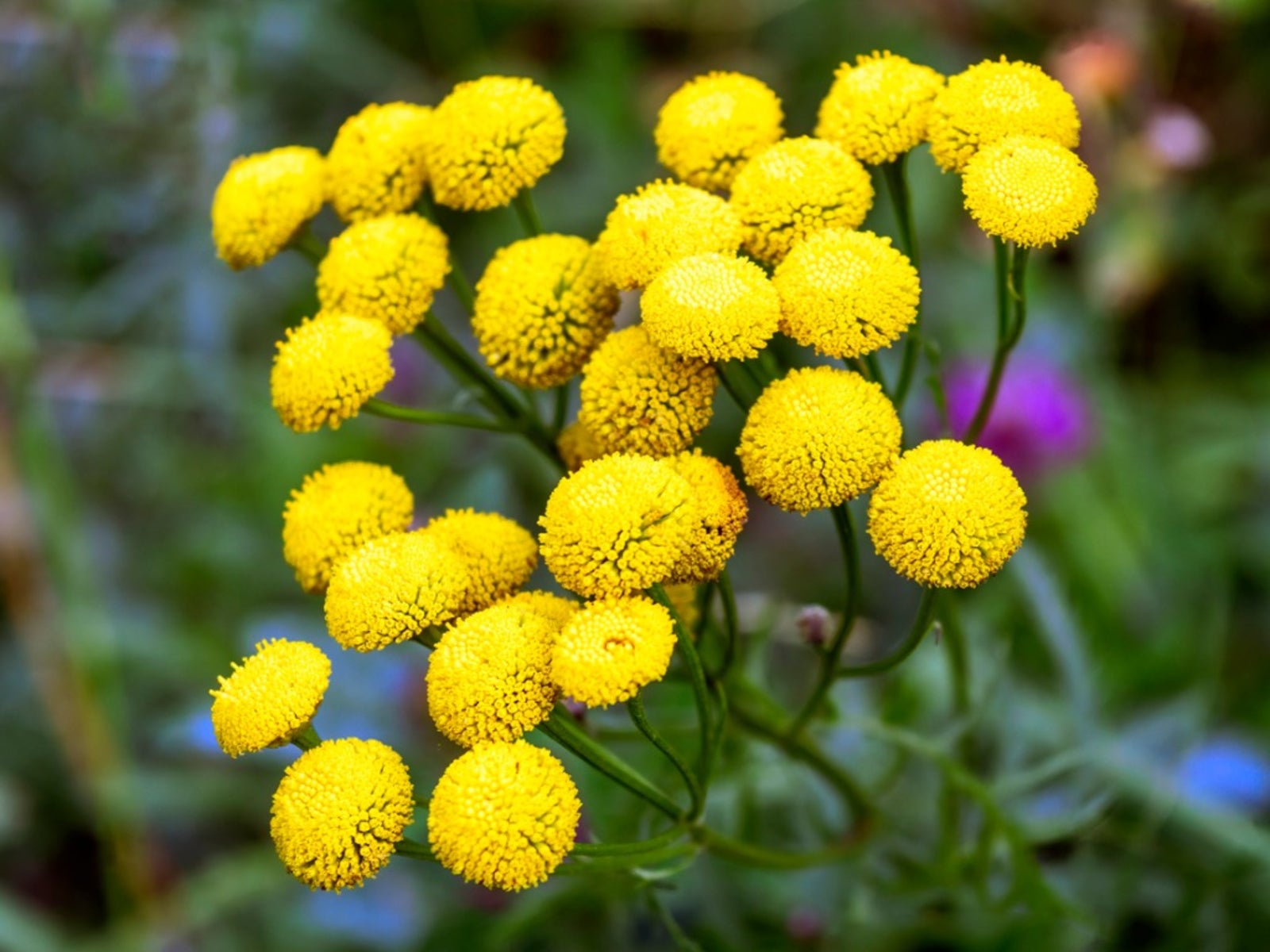With its clusters of bright yellow button-like flowers and ferny foliage, Tansy brings an old-world charm to gardens and borders. Once a staple in traditional medicinal and cottage gardens, it now earns its place for both ornamental value and insect-repelling properties.
Tansy is tough, bold, and a bit wild — ideal for those looking to add structure and vibrant color to their summer display while also supporting beneficial insects and deterring pests naturally.

Portrait of the Tansy
Tansy (Tanacetum vulgare) is a hardy herbaceous perennial in the Asteraceae family. Native to Europe and Asia, it’s known for its aromatic foliage, long-lasting blooms, and ability to naturalize in many conditions.
- Type: Herbaceous perennial
- Family: Asteraceae
- Common Names: Tansy, Common Tansy, Bitter Buttons
Foliage and Form
Tansy’s finely divided, fern-like foliage is aromatic and adds texture to garden beds. Its upright growth and clumping habit make it excellent for mid-border planting.
- Height: 60–120 cm (2–4 ft)
- Spread: 30–60 cm (1–2 ft)
- Growth Habit: Upright, clumping, spreads by rhizomes
Blooms and Fragrance
The golden-yellow flowers bloom in tight, flat-topped clusters and are highly attractive to pollinators — especially bees and butterflies.
- Bloom Time: Mid to late summer (July–September)
- Color: Bright yellow
- Fragrance: Strong, medicinal or camphor-like scent
The Right Time to Plant, Prune, and Enjoy Tansy
| Month | Planting | Flowering | Pruning |
|---|---|---|---|
| January | ❌ | ❌ | ❌ |
| February | ✅ Indoors (seeds) | ❌ | ❌ |
| March | ✅ Indoors or sow outdoors | ❌ | ❌ |
| April | ✅ Transplant seedlings | ❌ | ✅ Pinch to shape |
| May | ✅ | ❌ | ❌ |
| June | ❌ | ✅ Start | ❌ |
| July | ❌ | ✅ Peak bloom | ✅ Deadhead to prolong flowering |
| August | ❌ | ✅ | ✅ Trim faded blooms |
| September | ❌ | ✅ Final blooms | ✅ Light shaping |
| October | ❌ | ❌ | ✅ Cut back foliage post-bloom |
| November | ❌ | ❌ | ✅ Mulch or compost cut stems |
| December | ❌ | ❌ | ❌ |
✅ = Recommended ❌ = Not advised
Watering, Sunlight, and Environment for Tansy
Watering
Tansy is drought-tolerant once established and prefers light, well-drained soil.
- When to Water: Only during dry spells
- How Much: Light to moderate
- Watch out for: Overwatering, especially in heavy soils
Sunlight
To thrive and flower profusely, tansy needs full sun, though it tolerates partial shade.
- Ideal Exposure: 6–8 hours of sun per day
- Shady Sites: Tolerated, but may lead to leggy growth and fewer blooms
Indoor vs Outdoor
Tansy is an outdoor plant, best suited for wild gardens, herb borders, or pollinator beds. Indoors, it can become leggy and lacks airflow.
- Best Location: Garden beds, borders, cottage gardens
- Avoid: Growing indoors or in containers long-term
Temperature
This hardy plant tolerates cold winters and hot summers.
- Optimal Range: 10–27°C (50–81°F)
- Hardiness Zones: USDA zones 3–9
- Protection Tip: Minimal — this plant is tough!
Ideal Soil Conditions for Growing Tansy
| Soil Feature | Optimal Condition | Why It Matters |
|---|---|---|
| Soil Type | Loamy or sandy soil | Drains well, supports strong growth |
| Texture | Moderately fine | Allows root expansion |
| Drainage | Well-draining | Prevents root rot |
| Moisture | Low to moderate | Too much water weakens the plant |
| Soil pH | Neutral to slightly alkaline (6.5–7.5) | Tolerant of a broad range |
| Fertility | Low to moderate | Too much nitrogen causes floppiness |
Common Problems & Solutions
| Issue 🐾 | Symptoms 🔍 | Solutions 🛠️ |
|---|---|---|
| Overgrowth 🌿 | Aggressive spread, unwanted seedlings | Divide or root-barrier the area |
| Powdery Mildew 🌫️ | White coating on leaves | Improve air circulation, avoid overhead watering |
| Aphids 🐜 | Sticky leaves, curled stems | Spray with neem oil or insecticidal soap |
| Leggy Growth 🌱 | Sparse stems, few blooms | Provide full sun and cut back in spring |
| Unwanted Reseeding 🌼 | New plants popping up everywhere | Deadhead before seeds form |
Tansy is more than just a splash of yellow in a summer border — it’s a low-maintenance pollinator magnet, a natural pest deterrent, and a relic of herbal folklore. While it spreads readily, with a bit of attention and occasional trimming, it can be a bold, useful, and beautiful presence in your garden.